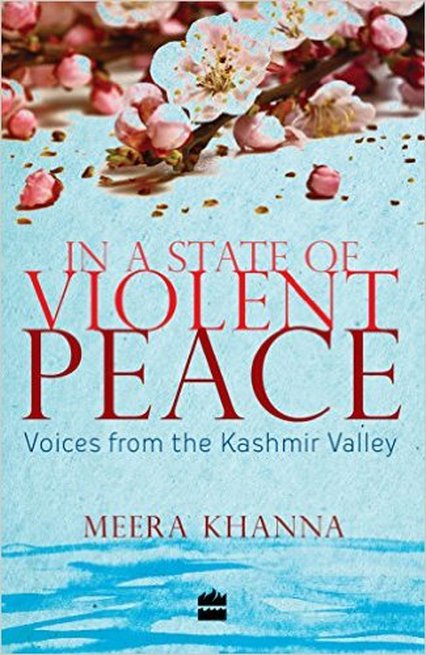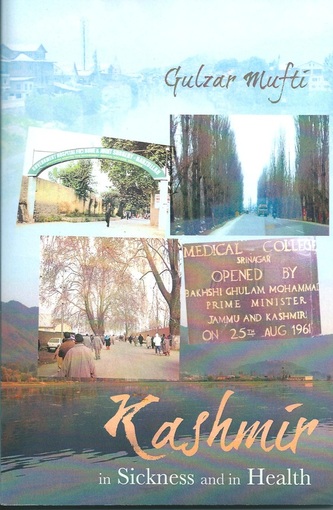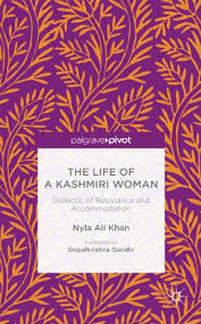Farah Bashir, Rumours of Spring: a girlhood in Kashmir - short notice
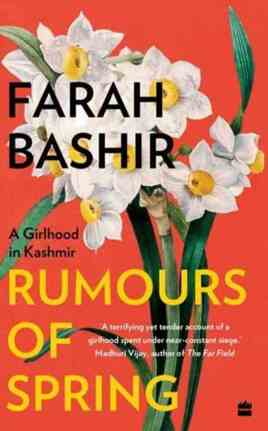
Rumours of Spring is an exceptionally effective account of growing up in Srinagar amid all-consuming violence and tension. It's Farah Bashir's memoir of her own childhood and adolescence - constructed around the death of her grandmother, 'Bobeh' in December 1994 when the author was 18.
Bobeh did not die a violent death. But through interweaving memories springing from her grandmother's final days, death and funeral, Bashir recites a powerfully affecting story of how a sense of dread and perpetual anxiety crimped and soured her girlhood, and took the lives of people she knew and cared about.
There is a beguiling innocence about the storytelling which draws the reader in - Bashir avoids sensationalism, and that makes her writing all the more engrossing. The curfew 'had its own way of slipping indoors, she writes lyrically at one point. At another, she describes the Valley's newspaper in the early 1990s as 'mortuaries laid out on broadsheets'.
Kashmir, of course, is still waiting for Spring. (AW)
Farah Bashir, Rumours of Spring: a girlhood in Kashmir, Fourth Estate: New Delhi, 2021
Bobeh did not die a violent death. But through interweaving memories springing from her grandmother's final days, death and funeral, Bashir recites a powerfully affecting story of how a sense of dread and perpetual anxiety crimped and soured her girlhood, and took the lives of people she knew and cared about.
There is a beguiling innocence about the storytelling which draws the reader in - Bashir avoids sensationalism, and that makes her writing all the more engrossing. The curfew 'had its own way of slipping indoors, she writes lyrically at one point. At another, she describes the Valley's newspaper in the early 1990s as 'mortuaries laid out on broadsheets'.
Kashmir, of course, is still waiting for Spring. (AW)
Farah Bashir, Rumours of Spring: a girlhood in Kashmir, Fourth Estate: New Delhi, 2021
Neerja Mattoo, The Mystic and the Lyric: four women poets from Kashmir
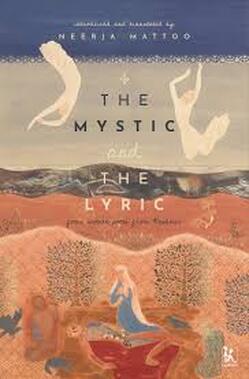
This is a work of scholarship and passion - written with a rare elegance. Neerja Mattoo looks at the lives and writing for four women poets from Kashmir who wrote in Kashmiri. The first two, Lalded and Habba Khatun, are well known; the latter two, Rupa Bhavani and Arnimal, less so. Mattoo discusses the context of their lives and writing, the verses themselves and their nature - some sacred or mystic, while others, and particularly Habba Khatun's poetry, are about love, longing and bear an erotic aspect.
Neerja Mattoo also translates the verses of all four poets into English - and while of course you lose something of the rhyme, rhythm and alliteration, non-Kashmiri speakers gain a valuable window on these writers' work.
Let me quote from Mattoo's introduction:
'The origins of the two main streams of Kashmiri poetry are the mystical compositions of Lalded (14th century) and the romantic, secular lyrics of Habba Khatun (16th century). Lalded was followed by Rupa Bhavani (17th century) in the mystic tradition, while Arnimal (in the 18th century) was heir to the romantic love lyrics of Habba Khatun. Each of these women charted her particular course in life and art, refusing in her own way to submit to the rules assigned by contemporary society. Two walked out of their marriages and the culture of silence to express their spiritual yearnings in verses of solemn beauty. The other two, separated from their lovers, openly spoke about their physical longing in the poetry of unforgettable songs. It helped that Kashmiris give mystics the liberty to break social taboos, the broken-hearted space to lament, and to treasure both.'
The publisher Zubaan have put together a handsome volume, and the striking cover is from the painting of Nilima Sheikh. (AW)
Neerja Mattoo, The Mystic and the Lyric: four women poets from Kashmir, Zubaan, New Delhi, 2019
Neerja Mattoo also translates the verses of all four poets into English - and while of course you lose something of the rhyme, rhythm and alliteration, non-Kashmiri speakers gain a valuable window on these writers' work.
Let me quote from Mattoo's introduction:
'The origins of the two main streams of Kashmiri poetry are the mystical compositions of Lalded (14th century) and the romantic, secular lyrics of Habba Khatun (16th century). Lalded was followed by Rupa Bhavani (17th century) in the mystic tradition, while Arnimal (in the 18th century) was heir to the romantic love lyrics of Habba Khatun. Each of these women charted her particular course in life and art, refusing in her own way to submit to the rules assigned by contemporary society. Two walked out of their marriages and the culture of silence to express their spiritual yearnings in verses of solemn beauty. The other two, separated from their lovers, openly spoke about their physical longing in the poetry of unforgettable songs. It helped that Kashmiris give mystics the liberty to break social taboos, the broken-hearted space to lament, and to treasure both.'
The publisher Zubaan have put together a handsome volume, and the striking cover is from the painting of Nilima Sheikh. (AW)
Neerja Mattoo, The Mystic and the Lyric: four women poets from Kashmir, Zubaan, New Delhi, 2019
Chitralekha Zutshi, Kashmir
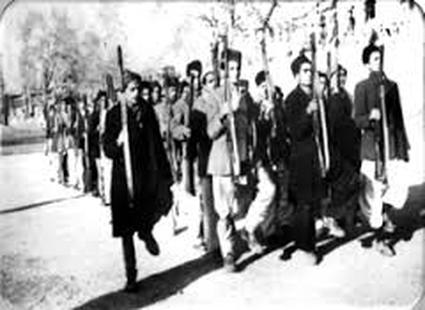
Chitralekha Zutshi, perhaps the foremost historian of Kashmir and herself a Kashmiri, has written a short but comprehensive book about Kashmir for the Oxford India Short Introductions series. It covers two-thousand years of Kashmiri history, imagining and identities, and Professor Zutshi bring to bear her profound scholarship about early modern Kashmir as well as delineating and reflecting on the past seventy-five years. It comes right up to date with the scrapping of Article 370.
Rather than offer a review of the book, we are posting here some very brief excerpts which give you a sense of the argument and of the quality of the writing:
Rather than offer a review of the book, we are posting here some very brief excerpts which give you a sense of the argument and of the quality of the writing:
(px) 'This book demonstrates that Kashmir is a place like any other, with a distinct but not unique past. Most importantly, in its indigenous intellectual tradition, it appears as the centre of literary and political culture, and not a distinct culture to be policed and secured. It became the focus of a conflict not because it is special or because it is an unruly borderland, but rather because of political developments in the last decade of British colonial rule and the moment of decolonization of the Indian subcontinent. The parties involved in the conflict, however, have laid claim to and refashioned the narrative of uniqueness that defined Kashmir and served particular political needs in the past, to justify their own claims to it in the present.'
(pp128-9 - on Sheikh Abdullah's first period in power, 1947-53) 'The dispute between India and Pakistan, both regionally and internationally, defined and ultimately overwhelmed the first regime of Jammu and Kashmir, whose relationship to the people of the state and to India foundered on the irresolution of this main issue. Caught between India-Pakistan and its people, the regime resorted to crushing all legitimate dissent and rendering Jammu and Kashmir, in effect, into a one-party state. India, for its part, by not encouraging, indeed actively thwarting, democratic processes in Kashmir, whose residents were Indian citizens, but only in name, saddled itself with a deeply politically discontented populace that would eventually rise up against it.'
(pp150-1) '... the resistance to the Indian state has grown and changed over the decades, with demands for azaadi taking on multiple meanings, from plebiscite, to freedom from injustice and tyranny, to outright independence. By choosing to blame Pakistan for what now appears to be a full-scale rebellion in the Valley, rather than accepting some culpability for the situation and attempting to arrive at a resolution of the issues plaguing the state through negotiations, the Indian and the regional governments of Jammu and Kashmir have effectively lost control of the Valley. Since Islam has become an oppositional identity for Kashmiri Muslims against the Indian state, the issue has taken on religious overtones, especially in an era of Hindu extremism, but it is important to not lose sight of the profound political grievances that continue to undergird this insurgency.'
(pp169-70 - after the move to make Article 370 null and void) 'The deep fear held by Kashmiri Muslims of demographic change in the Valley is now a real possibility as the constitutional amendments will allow any Indian citizen to own land in this union territory. The response in the Valley and outside to this move - which among other things is an attack on Indian federalism - remains to be seen. It has, however, proven beyond doubt that to the Indian state, and also perhaps to most Indian citizens, Kashmir is a mere territory devoid of people.'
(pp128-9 - on Sheikh Abdullah's first period in power, 1947-53) 'The dispute between India and Pakistan, both regionally and internationally, defined and ultimately overwhelmed the first regime of Jammu and Kashmir, whose relationship to the people of the state and to India foundered on the irresolution of this main issue. Caught between India-Pakistan and its people, the regime resorted to crushing all legitimate dissent and rendering Jammu and Kashmir, in effect, into a one-party state. India, for its part, by not encouraging, indeed actively thwarting, democratic processes in Kashmir, whose residents were Indian citizens, but only in name, saddled itself with a deeply politically discontented populace that would eventually rise up against it.'
(pp150-1) '... the resistance to the Indian state has grown and changed over the decades, with demands for azaadi taking on multiple meanings, from plebiscite, to freedom from injustice and tyranny, to outright independence. By choosing to blame Pakistan for what now appears to be a full-scale rebellion in the Valley, rather than accepting some culpability for the situation and attempting to arrive at a resolution of the issues plaguing the state through negotiations, the Indian and the regional governments of Jammu and Kashmir have effectively lost control of the Valley. Since Islam has become an oppositional identity for Kashmiri Muslims against the Indian state, the issue has taken on religious overtones, especially in an era of Hindu extremism, but it is important to not lose sight of the profound political grievances that continue to undergird this insurgency.'
(pp169-70 - after the move to make Article 370 null and void) 'The deep fear held by Kashmiri Muslims of demographic change in the Valley is now a real possibility as the constitutional amendments will allow any Indian citizen to own land in this union territory. The response in the Valley and outside to this move - which among other things is an attack on Indian federalism - remains to be seen. It has, however, proven beyond doubt that to the Indian state, and also perhaps to most Indian citizens, Kashmir is a mere territory devoid of people.'
Chitralekha Zutshi, Oxford India Short Introductions: Kashmir, Oxford University Press, New Delhi, 2019, ISBN 0-19-012141-6, ebook available
Anam Zakaria, Between the Great Divide: a journey into Pakistan-administered Kashmir - short notice
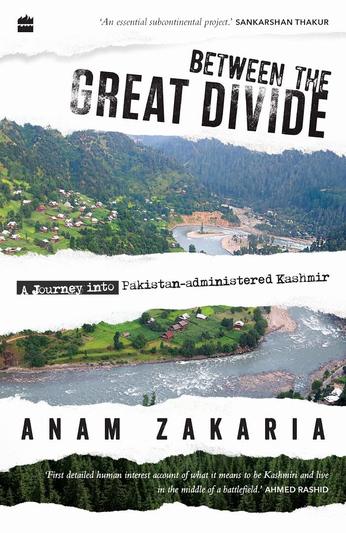
What an excellent book this is - engagingly written and truly revelatory. It is a commonplace to say that Azad Kashmir is the least understood part of the former princely state. Anam Zakaria, a Pakistani writer, became intrigued by a visit to the Neelum Valley. From that arose the idea for this book, a series of journeys, conversations and interviews across Pakistan-administered Kashmir. Zakaria presents herself as the innocent and enquiring outsider. She is much more than that: an acute observer with great compassion and not a little courage - and without a partisan drum to bang. By-and-large, she allows the people of Pakistan Kashmir to tell their own stories.
So we hear the voices that get drowned out in the conventional narrative: the long ago abducted Hindu and Sikh women who 'under the garb of their Muslim names ... remain hidden in the folds of Pakistani and 'Azad' Kashmiri cities and villages'; the women of the Neelum valley who say they want the struggle to end and that nothing has come out of it; the pro-independence campaigners who argue that Pakistan has been as oppressive as India; the Pakistani military man who concedes that the sidelining of the JKLF was a mistake; the former chief of army staff who insists that: "the line between terrorism and the freedom struggle getting blurred is an enormous blow to the Kashmiris".
Alongside the accounts of pan-Kashmiri and pan-Muslim sentiment, the anger and sorrow of those who have lost family members through Indian shelling and incursions, and the fury at what is widely seen as India's illegal occupation of the Kashmir Valley, other issues emerge. There's a profound sense of Kashmiri disquiet about their political and economic marginalisation within Pakistan, particularly acute in Kotli and Mirpur where huge and deeply disruptive dam construction has not delivered the dividend which the local population had every right to expect. Zakaria quotes an academic expert as saying of the Mirpuri community: "The Kashmiris see them as Punjabis and the Punjabis see them as Kashmiris". And she mentions in passing the 'many signboards in Chinese' evident in this area as new infrastructure projects take shape.
However well you think you know Kashmir, this book will take you by surprise. (AW)
Anam Zakaria, Between the Great Divide: a journey into Pakistan-administered Kashmir, HarperCollins India, 2018
So we hear the voices that get drowned out in the conventional narrative: the long ago abducted Hindu and Sikh women who 'under the garb of their Muslim names ... remain hidden in the folds of Pakistani and 'Azad' Kashmiri cities and villages'; the women of the Neelum valley who say they want the struggle to end and that nothing has come out of it; the pro-independence campaigners who argue that Pakistan has been as oppressive as India; the Pakistani military man who concedes that the sidelining of the JKLF was a mistake; the former chief of army staff who insists that: "the line between terrorism and the freedom struggle getting blurred is an enormous blow to the Kashmiris".
Alongside the accounts of pan-Kashmiri and pan-Muslim sentiment, the anger and sorrow of those who have lost family members through Indian shelling and incursions, and the fury at what is widely seen as India's illegal occupation of the Kashmir Valley, other issues emerge. There's a profound sense of Kashmiri disquiet about their political and economic marginalisation within Pakistan, particularly acute in Kotli and Mirpur where huge and deeply disruptive dam construction has not delivered the dividend which the local population had every right to expect. Zakaria quotes an academic expert as saying of the Mirpuri community: "The Kashmiris see them as Punjabis and the Punjabis see them as Kashmiris". And she mentions in passing the 'many signboards in Chinese' evident in this area as new infrastructure projects take shape.
However well you think you know Kashmir, this book will take you by surprise. (AW)
Anam Zakaria, Between the Great Divide: a journey into Pakistan-administered Kashmir, HarperCollins India, 2018
Chitralekha Zutshi (editor), Kashmir: History, Politics, Representation
review by Hafsa Kanjwal
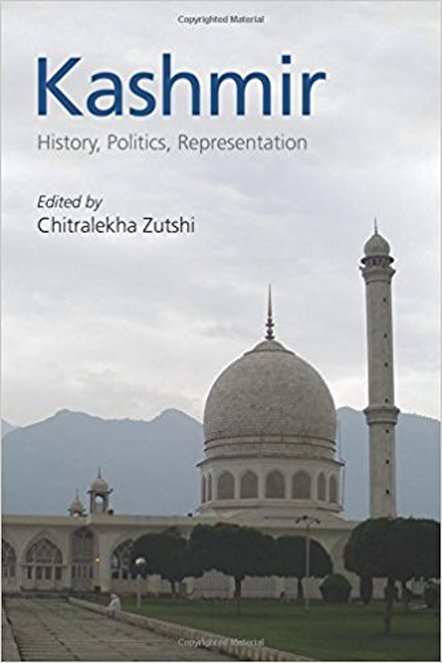
The edited volume Kashmir: History, Politics, Representation brings together fourteen essays on a variety of topics and themes pertaining to the region of Kashmir, ranging from the fourteenth century into the present day. This collection, which brings forth interdisciplinary work from a wide range of fields, including literature, film and media studies, gender studies, history, political science, anthropology, religious studies, and sociology, attempts to move beyond the high politics of the Kashmir conflict, and destabilize the notion of Kashmir as simply a disputed territory, while considering “less well-known aspects and areas of Kashmir” (3). In doing so, it aims to “illuminate the diversity and range of experiences, ideas, institutions, individuals, forms of resistance and interactions with the outside world that have shaped, and continue to shape, Kashmir and its people” (ix).
To be sure, the sheer range of scholarly possibilities that the volume as a whole considers is promising. The study of Kashmir has made substantial progress from the time when it was mired in scholarly disputes over the nature of events in 1947 or analysis of the multiple causes of the armed uprising against the Indian state in the late 1980s.
The volume builds upon recent developments in the historiography of Kashmir. One, the essays expand the geography of focus from the Kashmir Valley to the other regions of the princely state of Jammu and Kashmir that are “very much a part of the Kashmir dispute” (3). Christopher Snedden’s work highlights the importance of Azad Kashmir as instigating the Kashmir dispute, and depicts its contested relationship within Pakistan, as it is highly dependent on Pakistan, and therefore “lacks integrity as a genuinely autonomous entity.” Martin Sokefeld’s work in Gilgit-Baltistan shows the antagonistic political aspirations of the people of the region, who wish to fully integrate into Pakistan, but continue to be treated as part of a “disputed territory” and thus do not enjoy the full merits of citizenship. Mohita Bhatia’s compelling look into caste politics in Jammu reveals how everyday dalit assertion against the upper castes can still co-exist with their participation in a pro-Hindu and nationalist politics that stands in contrast to Kashmiri Muslim aspirations for freedom in the Valley (11). Here, regional/religious identity overshadows caste identities and solidarities.
To be sure, the sheer range of scholarly possibilities that the volume as a whole considers is promising. The study of Kashmir has made substantial progress from the time when it was mired in scholarly disputes over the nature of events in 1947 or analysis of the multiple causes of the armed uprising against the Indian state in the late 1980s.
The volume builds upon recent developments in the historiography of Kashmir. One, the essays expand the geography of focus from the Kashmir Valley to the other regions of the princely state of Jammu and Kashmir that are “very much a part of the Kashmir dispute” (3). Christopher Snedden’s work highlights the importance of Azad Kashmir as instigating the Kashmir dispute, and depicts its contested relationship within Pakistan, as it is highly dependent on Pakistan, and therefore “lacks integrity as a genuinely autonomous entity.” Martin Sokefeld’s work in Gilgit-Baltistan shows the antagonistic political aspirations of the people of the region, who wish to fully integrate into Pakistan, but continue to be treated as part of a “disputed territory” and thus do not enjoy the full merits of citizenship. Mohita Bhatia’s compelling look into caste politics in Jammu reveals how everyday dalit assertion against the upper castes can still co-exist with their participation in a pro-Hindu and nationalist politics that stands in contrast to Kashmiri Muslim aspirations for freedom in the Valley (11). Here, regional/religious identity overshadows caste identities and solidarities.
While the attention to the multilayered politics of the entire state is important, I suggest that it has often been misappropriated by particular political agendas that seek to undermine the demand for self-determination—not just in the Kashmir Valley but also throughout the state. Indeed, in an article for Kindle Magazine anthropologist Mona Bhan asks, “To what extent is this narrative meant to detract from the foundational question of Kashmir’s disputed political status in order to reinforce the justness and legitimacy of India’s rule over Kashmir?” While the edited volume calls for a multi-pronged approach to address this diversity in any solution to the Kashmir dispute, it is crucial that this diversity not be utilized to showcase the “intractable nature of political divides in the state”. Furthermore, it is important to foreground the role of statecraft in crafting or manipulating existing divisions along religious/regional/or linguistic lines.
Two, these essays also show how particular manifestations of religious identity as well as relations between diverse religious communities come to be constructed over a particular historical period and in response to specific socio-economic developments. In doing so, they shift our attention away from essentialist understandings of religious identities and their interactions. Mridu Rai’s essay examines how Kashmiri Muslims used the colonial archeological project in Kashmir as a means to demand control over religious spaces, as well as political rights as a community. Not unlike colonial practices of statecraft such as the census, “archeology ended up amplifying religiously defined identities within communities” (27). Chitralekha Zutshi’s essay foregrounds contestations over urban space—in particular, shrines—under the Dogras and how these contestations came to shape how Islam in Kashmir would be defined, and how Kashmiri Muslim protest against the state would take form. Haley Duschinski’s article on Kashmiri Hindus showcases how homogenizing community discourses by Kashmiri Pandit organizations after 1990 “reflected and refracted right-wing majoritarian projects of the saffron wave of Hindu nationalism” (172). This affinity was constructed over a series of events; it was not a teleological given at the time of Pandit migration to Jammu. In addition, Ananya Jahanara Kabir’s essay on the changing representations of Kashmir in popular Indian cinema since the 1960s highlights how India’s anxieties about its own Muslim population, especially in the context of the War on Terror, is able to ideologically coopt the Kashmir issue, and portray Kashmiri Muslims as violent terrorists. All of these essays underscore how colonial practices of statecraft, contestations over religious space, migration, and cinema shape particular manifestations of religious identities, and their relationship to the state.
Three, these essays also situate Kashmir in a longue duree of relations, politics, and identities. Using a number of different texts, including hagiographies, across centuries, Dean Accardi’s essay shows how the indigenous medieval mystics, Lala Ded and Nund Rishi, were deployed for diverse political ends by the writers of these texts. In the act of narration, however, they became embedded in the Kashmiri spiritual landscape. The “cumulative result of these retellings is a weaving of these saints deeper and deeper into the fabric of Kashmir, and Kashmiri identity, thus rendering them synonymous with Kashmir itself,” Accardi concludes (262). Vanessa Chishti’s work examines the Kashmiri shawl as central to European representations of Kashmir in the late 18th and 19th centuries. When Kashmiri shawls were deemed exclusive and authentic, Kashmir was posited as an untouched paradise in European narratives. As Europe began to mass-produce shawls, the desire for Kashmiri shawls fell, and the representation of Kashmir shifted. As Chishti argues, the “Valley came to be seen as a frontier of the British empire and the theater for British capital and enterprise” (280).
The remainder of the essays directly confront the politics of the present. Andrew Whitehead’s essay uses the story of Naya (New) Kashmir to show how “there has been no enduring settlement between Kashmiri and Indian nationalisms, no agreement about the extent of autonomy for the state, and it is not hard to see why such a resolution has proved so elusive” (86). Shehla Hussain writes of the shifting meanings of the term azadi from the 1930’s to the present. She dispels the notion of freedom as a recent construct, and argues that it’s meaning must be broadened from political emancipation to a “concept informed by human dignity, economic equity and social justice”(90). Reeta Chowdhari Tremblay asks whether good governance can mitigate people’s demands for freedom. She argues that it cannot, as it does not address “the deeper demands for dignity and social justice that are integral to Kashmiris sense of religion and regional identity” (11). In the last chapter, Suvir Kaul looks at a number of poems to explore trauma and resistance. He argues that these poems are not just a means of resistance, but also challenge tropes of loss, discord, and dispossession itself, in an attempt to build towards a more ethical future and serve as a conduit of political mobilization.
While the chapters each push the direction of Kashmir Studies in the aforementioned directions, the introductory chapter by Zutshi entitled “New Directions in the Study of Kashmir,” fails to truly break ground in articulating the “newness” in approaches to studying Kashmir and upholds a number of (Indian) statist perspectives, not dissimilar to an earlier round of historiography that sought to reclaim Kashmir for India.
In the introduction, the region of Kashmir is defined in reference to historical literature—in both Sanskrit and Persian—as well as Kashmir’s incorporation into the princely state of Jammu and Kashmir in the colonial period. However, the scope of Kashmir Studies itself is not examined. Why is it important to have “Kashmir Studies” and what are some of its important thematic and theoretical contributions? While the introduction makes reference to how the set of essays reflect the failures of the postcolonial era, more could be said in interrogating the use of both “colonial” and “postcolonial” in relation to Kashmir.
Further, the introduction argues that the set of essays transcend the meta-narratives of political conflict to probe other, equally significant, arenas of conflict that inform the Kashmir dispute (3). What is seen as “political conflict” is not clarified—indeed, a vast majority of the essays do touch upon politics—broadly defined—and the political conflict is implicated and plays a crucial role in the types of questions a vast majority of the essays are examining. Thus, it is perhaps not useful to “transcend” political conflict, but rather, foreground it as working alongside other arenas of conflict. For example, it would be difficult to imagine the extent of gender violence in Seema Kazi’s essay without foregrounding the political conditions upon which Indian forces are able to exercise complete impunity.
In addition, when speaking of Kashmir, the language that scholars use is laden with particular meanings and political intent. For there to indeed be a new direction in Kashmir Studies, we must be, first and foremost, ready to shed the burden of nationalist discourses that continue to idealize the nation-state, and Kashmiri aspirations as being simply “alienated” from this ideal. This begins with challenging the use of the term “conflict” as it foregrounds Indian and Pakistani nationalist narratives over those of Kashmiris (which the purportedly volume seeks to do). At what point, then, do we shift our frames from seeing Kashmir more accurately as a military occupation instead of an interstate “conflict”? In the introduction, and elsewhere, there are also repeated references to the “insurgency,” and “secessionist” politics which, once again foregrounds Indian statist narratives, and frames the issue exclusively from a security lens.
Indeed, there are a number of times in the introduction where an attempt is made to reclaim Kashmir, in particular for the Indian state, by asking how national movements can be accommodated within states instead of being seen as threats to the national interest. Zutshi states “Kashmiri nationalism, which at one time seemed perfectly aligned with the narrative of Indian nationalism, now seemed irreconcilable with it” (9). A cursory look at Kashmiri nationalism will reveal how it was always deeply fractured and contested; while a particular elite group of Kashmiri leaders may have identified with Indian nationalism, there is no evidence to suggest that “Kashmiri nationalism” as a whole did so. Even this elite group had their own qualms about Indian nationalism, as we can see in the case of Sheikh Abdullah.
Zutshi also argues “Kashmiris seek to distance themselves from India and claim a greater identification of Kashmir with the Islamic world, defined increasingly in West Asian rather than South Asian terms.” One could of course question why Kashmir needs to be reclaimed exclusively on South Asian terms; surely a region such as Kashmir, which existed at the confluence of multiple civilizations can go beyond the contours of South Asia. Furthermore, why is a greater identification with the entity known as the “Islamic world” immediately seen as a negative development? Perhaps a more critical question would be to examine exactly how Kashmir came to exclusively fall within the ambit of “South Asia.”
Two, these essays also show how particular manifestations of religious identity as well as relations between diverse religious communities come to be constructed over a particular historical period and in response to specific socio-economic developments. In doing so, they shift our attention away from essentialist understandings of religious identities and their interactions. Mridu Rai’s essay examines how Kashmiri Muslims used the colonial archeological project in Kashmir as a means to demand control over religious spaces, as well as political rights as a community. Not unlike colonial practices of statecraft such as the census, “archeology ended up amplifying religiously defined identities within communities” (27). Chitralekha Zutshi’s essay foregrounds contestations over urban space—in particular, shrines—under the Dogras and how these contestations came to shape how Islam in Kashmir would be defined, and how Kashmiri Muslim protest against the state would take form. Haley Duschinski’s article on Kashmiri Hindus showcases how homogenizing community discourses by Kashmiri Pandit organizations after 1990 “reflected and refracted right-wing majoritarian projects of the saffron wave of Hindu nationalism” (172). This affinity was constructed over a series of events; it was not a teleological given at the time of Pandit migration to Jammu. In addition, Ananya Jahanara Kabir’s essay on the changing representations of Kashmir in popular Indian cinema since the 1960s highlights how India’s anxieties about its own Muslim population, especially in the context of the War on Terror, is able to ideologically coopt the Kashmir issue, and portray Kashmiri Muslims as violent terrorists. All of these essays underscore how colonial practices of statecraft, contestations over religious space, migration, and cinema shape particular manifestations of religious identities, and their relationship to the state.
Three, these essays also situate Kashmir in a longue duree of relations, politics, and identities. Using a number of different texts, including hagiographies, across centuries, Dean Accardi’s essay shows how the indigenous medieval mystics, Lala Ded and Nund Rishi, were deployed for diverse political ends by the writers of these texts. In the act of narration, however, they became embedded in the Kashmiri spiritual landscape. The “cumulative result of these retellings is a weaving of these saints deeper and deeper into the fabric of Kashmir, and Kashmiri identity, thus rendering them synonymous with Kashmir itself,” Accardi concludes (262). Vanessa Chishti’s work examines the Kashmiri shawl as central to European representations of Kashmir in the late 18th and 19th centuries. When Kashmiri shawls were deemed exclusive and authentic, Kashmir was posited as an untouched paradise in European narratives. As Europe began to mass-produce shawls, the desire for Kashmiri shawls fell, and the representation of Kashmir shifted. As Chishti argues, the “Valley came to be seen as a frontier of the British empire and the theater for British capital and enterprise” (280).
The remainder of the essays directly confront the politics of the present. Andrew Whitehead’s essay uses the story of Naya (New) Kashmir to show how “there has been no enduring settlement between Kashmiri and Indian nationalisms, no agreement about the extent of autonomy for the state, and it is not hard to see why such a resolution has proved so elusive” (86). Shehla Hussain writes of the shifting meanings of the term azadi from the 1930’s to the present. She dispels the notion of freedom as a recent construct, and argues that it’s meaning must be broadened from political emancipation to a “concept informed by human dignity, economic equity and social justice”(90). Reeta Chowdhari Tremblay asks whether good governance can mitigate people’s demands for freedom. She argues that it cannot, as it does not address “the deeper demands for dignity and social justice that are integral to Kashmiris sense of religion and regional identity” (11). In the last chapter, Suvir Kaul looks at a number of poems to explore trauma and resistance. He argues that these poems are not just a means of resistance, but also challenge tropes of loss, discord, and dispossession itself, in an attempt to build towards a more ethical future and serve as a conduit of political mobilization.
While the chapters each push the direction of Kashmir Studies in the aforementioned directions, the introductory chapter by Zutshi entitled “New Directions in the Study of Kashmir,” fails to truly break ground in articulating the “newness” in approaches to studying Kashmir and upholds a number of (Indian) statist perspectives, not dissimilar to an earlier round of historiography that sought to reclaim Kashmir for India.
In the introduction, the region of Kashmir is defined in reference to historical literature—in both Sanskrit and Persian—as well as Kashmir’s incorporation into the princely state of Jammu and Kashmir in the colonial period. However, the scope of Kashmir Studies itself is not examined. Why is it important to have “Kashmir Studies” and what are some of its important thematic and theoretical contributions? While the introduction makes reference to how the set of essays reflect the failures of the postcolonial era, more could be said in interrogating the use of both “colonial” and “postcolonial” in relation to Kashmir.
Further, the introduction argues that the set of essays transcend the meta-narratives of political conflict to probe other, equally significant, arenas of conflict that inform the Kashmir dispute (3). What is seen as “political conflict” is not clarified—indeed, a vast majority of the essays do touch upon politics—broadly defined—and the political conflict is implicated and plays a crucial role in the types of questions a vast majority of the essays are examining. Thus, it is perhaps not useful to “transcend” political conflict, but rather, foreground it as working alongside other arenas of conflict. For example, it would be difficult to imagine the extent of gender violence in Seema Kazi’s essay without foregrounding the political conditions upon which Indian forces are able to exercise complete impunity.
In addition, when speaking of Kashmir, the language that scholars use is laden with particular meanings and political intent. For there to indeed be a new direction in Kashmir Studies, we must be, first and foremost, ready to shed the burden of nationalist discourses that continue to idealize the nation-state, and Kashmiri aspirations as being simply “alienated” from this ideal. This begins with challenging the use of the term “conflict” as it foregrounds Indian and Pakistani nationalist narratives over those of Kashmiris (which the purportedly volume seeks to do). At what point, then, do we shift our frames from seeing Kashmir more accurately as a military occupation instead of an interstate “conflict”? In the introduction, and elsewhere, there are also repeated references to the “insurgency,” and “secessionist” politics which, once again foregrounds Indian statist narratives, and frames the issue exclusively from a security lens.
Indeed, there are a number of times in the introduction where an attempt is made to reclaim Kashmir, in particular for the Indian state, by asking how national movements can be accommodated within states instead of being seen as threats to the national interest. Zutshi states “Kashmiri nationalism, which at one time seemed perfectly aligned with the narrative of Indian nationalism, now seemed irreconcilable with it” (9). A cursory look at Kashmiri nationalism will reveal how it was always deeply fractured and contested; while a particular elite group of Kashmiri leaders may have identified with Indian nationalism, there is no evidence to suggest that “Kashmiri nationalism” as a whole did so. Even this elite group had their own qualms about Indian nationalism, as we can see in the case of Sheikh Abdullah.
Zutshi also argues “Kashmiris seek to distance themselves from India and claim a greater identification of Kashmir with the Islamic world, defined increasingly in West Asian rather than South Asian terms.” One could of course question why Kashmir needs to be reclaimed exclusively on South Asian terms; surely a region such as Kashmir, which existed at the confluence of multiple civilizations can go beyond the contours of South Asia. Furthermore, why is a greater identification with the entity known as the “Islamic world” immediately seen as a negative development? Perhaps a more critical question would be to examine exactly how Kashmir came to exclusively fall within the ambit of “South Asia.”
Hafsa Kanjwal is an assistant professor of South Asian history at Lafayette College in the United States
Chitralekha Zutshi (editor), Kashmir: History, Politics, Representation, Cambridge University Press, 2018, ISBN: 978-1108402101
Nayeema Mahjoor, Lost in Terror - short notice
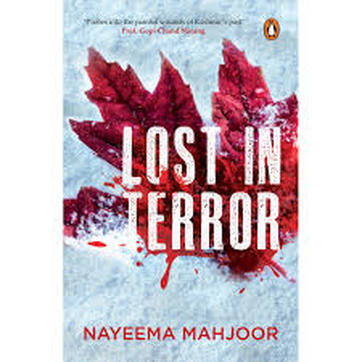
Nayeema Mahjoor has written a brave, powerful and deeply personal account of living in Srinagar through the early - and most violent - years of the separatist insurgency and the Indian army's response to it. As literature, it is perhaps not as polished as some other novels which have addressed this period in Kashmir's recent past. But as testimony - and as a means of evoking the anguish and anxiety of living amid assassinations and crackdowns - it is quite exceptional.
The story is told from a woman's point of view, and it touches on childbirth, a troubled marriage, sexual violence, dress and behaviour codes and many issues which only occasionally receive a public airing.
Nayeema Mahjoor was for many years a journalist and editor with the BBC Urdu service in London and is currently chairperson of the State Commission for Women in Jammu and Kashmir. (AW)
The story is told from a woman's point of view, and it touches on childbirth, a troubled marriage, sexual violence, dress and behaviour codes and many issues which only occasionally receive a public airing.
Nayeema Mahjoor was for many years a journalist and editor with the BBC Urdu service in London and is currently chairperson of the State Commission for Women in Jammu and Kashmir. (AW)
Nayeema Mahjoor, Lost in Terror, Penguin India, 2016, ISBN 9780143416531
Do You Remember Kunan Poshpora? - short notice
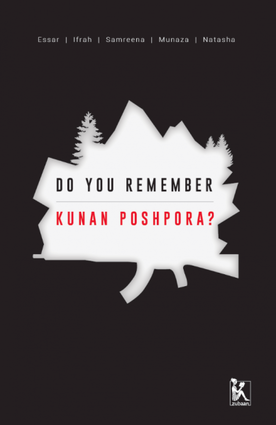
This is a brave and impressive book written by five young Kashmiri women - Essar Batool, Ifrah Butt, Samreena Mushtaq, Munaza Rashid and Natasha Rather - about the notorious mass rape committed by Indian troops in the twin villages of Kunan and Poshpora near Kupwara. That outrage occurred in February 1991, and in this detailed account the authors explain precisely what happened, the steps taken to cover up the incident, and the impact on the women and the villages.
The women who have compiled this book are activists. Each provides an account of how they became involved in pursuing the story of Kunan Poshpora. Most of them grew up assuming that Indian troops were in Kashmir to protect them - it was as students and young adults that they became aware of the abuses perpetrated by some Indian soldiers. One of the saddest aspects of their account is the acute stigma suffered by all who live in what have become known as 'the rape villages' - adding hugely to the burden and distress of the women affected.
Each author has taken responsibility for a chapter, which means there's some repetition and the book is at time disjointed. But this is a minor criticism of an important book which deserves a wide readership. (AW)
The women who have compiled this book are activists. Each provides an account of how they became involved in pursuing the story of Kunan Poshpora. Most of them grew up assuming that Indian troops were in Kashmir to protect them - it was as students and young adults that they became aware of the abuses perpetrated by some Indian soldiers. One of the saddest aspects of their account is the acute stigma suffered by all who live in what have become known as 'the rape villages' - adding hugely to the burden and distress of the women affected.
Each author has taken responsibility for a chapter, which means there's some repetition and the book is at time disjointed. But this is a minor criticism of an important book which deserves a wide readership. (AW)
Do You Remember Kunan Poshpora?, Zubaan, 2016, ISBN: 978 93 84757 66 3
Sunil Khilnani, Incarnations: India in 50 Lives - short notice
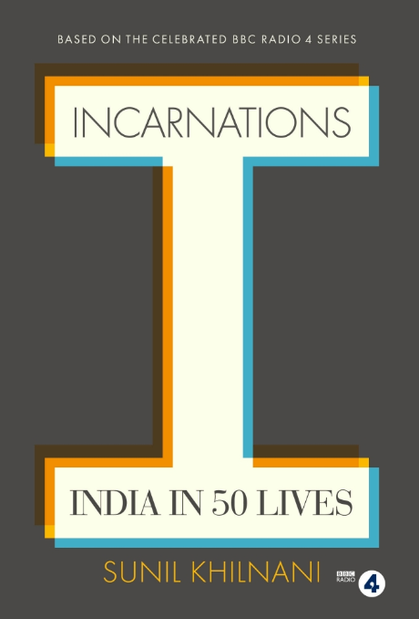
Sunil Khilnani - one of the most sparkling writers about modern India - has put together a fifty-programme radio series for the BBC telling the story of the nation through brief biographies. The accompanying book is if anything more effervescent than the radio version - it's wonderfully illustrated and runs to more than 600 pages. The Indians featured range from the Buddha to Ambani, and include Jinnah, Gandhi (Mahatma and Indira) ... but not Nehru - an omission no doubt intended to stir controversy, but surely a mistake. Another annoyance is the absence of an index.
Sheikh Abdullah is among those subject to Khilnani's wise and sometimes lacerating assessment. He has a great eye for the strong quote or telling anecdote - and how nice to see the striking cover of the 1944 New Kashmir manifesto as a full-page colour illustration.
Khilnani is refreshingly outspoken on the Kashmiri crisis: 'To some Indians today, the Kashmir conflict feels like a long-running sideshow. In truth, it goes to the core of India's commitment to political liberty. ... In short, the rulers of Kashmir today are not unlike the Dogras under whose boot Mohammad Abdullah grew up - a boot that shaped, and eventually hardened, his politics, just as the Indian government boot shapes and hardens the politics of young Kashmiris today.' That's certainly telling it straight! (AW)
Sheikh Abdullah is among those subject to Khilnani's wise and sometimes lacerating assessment. He has a great eye for the strong quote or telling anecdote - and how nice to see the striking cover of the 1944 New Kashmir manifesto as a full-page colour illustration.
Khilnani is refreshingly outspoken on the Kashmiri crisis: 'To some Indians today, the Kashmir conflict feels like a long-running sideshow. In truth, it goes to the core of India's commitment to political liberty. ... In short, the rulers of Kashmir today are not unlike the Dogras under whose boot Mohammad Abdullah grew up - a boot that shaped, and eventually hardened, his politics, just as the Indian government boot shapes and hardens the politics of young Kashmiris today.' That's certainly telling it straight! (AW)
Sunil Khilnani, Incarnations: India in 50 Lives, Allen Lane, 2016, ISBN: 978-0-241-20822-9
Nandita Haksar, The Many Faces of Kashmiri Nationalism
review by Hafsa Kanjwal
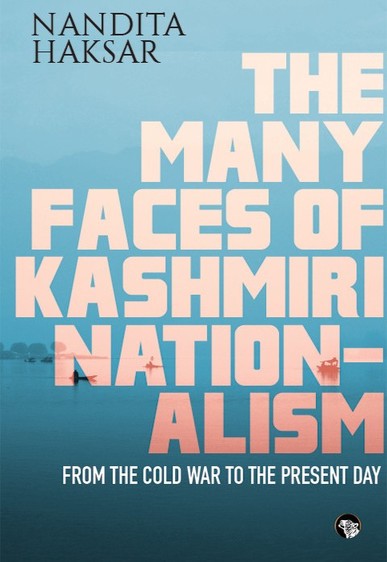
Nandita Haksar’s The Many Faces of Kashmiri Nationalism from the Cold War to the Present Day explores the history of contemporary Kashmir through the lives of Sampat Prakash, a Kashmiri Pandit and communist trade union leader, and Mohammad Afzal Guru, a Kashmiri Muslim who was accused of conspiring in the attack on the Indian parliament in 2001 and subsequently hanged in 2013.
Throughout the book, Haksar attempts to trace the intersection of religion and nationalism in the Kashmiri struggle for self-determination, and the ways it has been influenced and undermined by both Indian and Pakistani nationalisms as well as Western imperialism.
For Haksar, focusing on Prakash and Guru are important in that they are both representative of a Kashmiri nationalism that is deeply connected to a desire for dignity and justice as well as a commitment to inclusivity. Nevertheless, the worlds that Prakash and Guru inhabited were vastly different. Prakash became active in politics at a time when communist ideologies played an important role in Kashmir, while Guru’s activism was in the context of the fall of the Soviet Union and the rise of global Muslim solidarities and political Islam. This shift is how Haksar situates the redefinition of Kashmiri nationalism in the present day.
Woven into their stories are the stories of a number of other important Kashmiri figures and leaders—mostly male—and their impact on the Kashmiri struggle for self determination. These individuals range from prominent political leaders such as Sheikh Abdullah and Bakshi Ghulam Mohammad, pro-freedom leaders such as Yasin Malik and Syed Ali Shah Geelani, as well as little known figures such as Professor Durrani, who would teach Kashmiri youth about communism and Ghulam Mohiuddin Punoo, a trade union leader. Very few stories are narrated of women; while Haksar acknowledges this limitation, one wishes that more attempts were made to reach out to women from all walks of life.
Haksar’s narrative largely centers on Sampat Prakash, tracing his birth, childhood and memories of kashmiriyat, which he describes as harmony between Kashmiri Muslims and Hindus. According to Prakash, this harmony has been threatened by events in the region in recent decades, and the increasing shift towards right-wing Hindu and Muslim politics within both communities. Nevertheless, Prakash holds on to his dreams of kashmiriyat, despite the increasingly tense realities of the world around him. He is a Kashmiri Pandit, with deep roots to that identity, and is also deeply critical of the Indian state and its actions against Kashmiri Muslims, a position that often puts him in conflict with members of his community. He has fought, in various capacities, and often with those whose ideologies differ from him, to bring the Kashmiri struggle to light, longing for an independent, secular, and progressive Kashmir. Yet, he is constantly sidelined, and perhaps only tolerated for being the “token Pandit”, according to Haksar.
The primary contribution of this book is its unearthing of leftist politics in Kashmir. While the impact of communist ideology in Kashmir beyond the political establishment might be exaggerated, the actual stories of those who operated in alternative political spheres have been marginalized by the over-emphasis on the various political parties. For Prakash, this alternative political universe, the one place where he witnessed the existence of kashmiriyat, existed in the form of the trade unions that were active in the 1960’s and 1970’s. Prakash was the head of the Low Paid Government Servants Federation, which worked not only with those in service, but also private teachers, cleaning staff in municipalities, gardeners, daily wage earners, and ponywalas. It was comprised of both Pandits and Muslims. All in all, the Federation was responsible for improving the living and working conditions of more than four million workers. It held protests, strikes, and educated those working in various industries on their rights. While the Federation primarily focused on improving the living conditions and treatment of workers, it was never too far from politics. For example, it was involved in protests and agitations held in Kashmir after the infamous Indira-Sheikh Accord of 1975. As a result, Sheikh Abdullah arrested a number of union leaders for their activism. During the militancy, Prakash describes how the militants disapproved of the secular politics of the trade unionists, and he and his colleagues were threatened for many years. Nevertheless, the employees that were affiliated with the Federation continued to work throughout the insurgency, and the union leaders believe that they saved the Kashmiri economy from dying. Unfortunately, the Federation itself was co-opted as it was deemed to have communist links and was forced to operate under a different name, this time under the Hurriyat. Haksar projects these unions as the only space that perhaps had idealized democratic secular politics (although, she admits they were deeply patriarchal). They had their differences with the increasingly religious and pro-Pakistani elements of the militancy, but were also deeply against the Indian state.
Haksar admits that she is skeptical of Prakash’s perspectives on kashmiriyat. But she does not engage with the issue of Pandit-Muslim tensions on a deeper level. This is one of the main weaknesses of her book. We are left with a range of anecdotes -some of Kashmiri Muslims who tell her how they long for Pandits to return (which she questions as them catering to her as a Kashmiri Pandit), others of hostility. We are told of a group of young boys dressed in salvar kameez who scornfully look upon Kashmiri Pandits who have come back to visit their old homes. But what of those who welcomed their old neighbors? She has a tendency to share an anecdote, without providing appropriate context or analysis, leaving the reader to wonder what her intention was of including it.
The last section of the book focuses on the life of Mohammed Afzal Guru. It is a life that Haksar was deeply familiar with, as she served as a lawyer and activist for Guru and the others who were accused alongside him (and later freed). She describes his foray with militancy, his disillusionment with the role of Pakistan, and his decision to become a surrendered militant, so that he could begin a new life with his wife, Tabassum and son, Ghalib. She then details how he was harassed and tortured to provide information to the police and special operations forces and how he unintentionally helped one of the attackers buy a vehicle in Delhi. The story of Afzal Guru is a devastating one, especially because his story has been co-opted by various groups for their own political ends. Haksar narrates how the intelligence agencies tried to portray Afzal as a radical Salafi, when she saw him as a disgruntled Kashmiri nationalist who was turning more towards religion, but was not exclusivist in his thinking. She also hints towards the unsavory role of the Hurriyat and other pro-freedom groups, and how she “realised that various vested interests were making sure that Afzal didn’t escape from gallows.”
It is here that the lives of the two men, Prakash and Guru, merge together. Both had a vision for Kashmir that was marginalized not only explicitly by Indian and Pakistani nationalisms, but also undermined implicitly by groups within Kashmir. This dynamic has been the tragedy of Kashmiri nationalism.
The book is written in a style that mixes her personal reflections, the accounts of a number of Kashmiris – Muslim and Pandit –as well as history and analysis gleaned from various secondary sources. At some points, the narrative voices merge, and the reader is unable to determine whether we are hearing Haksar’s perspective or from one of her interlocutors. Haksar’s voice is that of a staunch secular Indian nationalist, which at times colors some of her analysis. A number of statements are made without mentioning their significance. Larger general claims are also made without evidence, including her bizarre assertion that at one point Kashmiris had wanted to be a part of India (how can we ascertain this?), but the tide of Hindu nationalism turned them off.
Nonetheless, the book is a welcome contribution to the literature on Kashmir, for the multiple political possibilities that it unearths.
Hafsa Kanjwal is a PhD candidate in History and Women's Studies at the University of Michigan, Ann Arbor, focusing on Islam in South Asia and modern Kashmir.
Throughout the book, Haksar attempts to trace the intersection of religion and nationalism in the Kashmiri struggle for self-determination, and the ways it has been influenced and undermined by both Indian and Pakistani nationalisms as well as Western imperialism.
For Haksar, focusing on Prakash and Guru are important in that they are both representative of a Kashmiri nationalism that is deeply connected to a desire for dignity and justice as well as a commitment to inclusivity. Nevertheless, the worlds that Prakash and Guru inhabited were vastly different. Prakash became active in politics at a time when communist ideologies played an important role in Kashmir, while Guru’s activism was in the context of the fall of the Soviet Union and the rise of global Muslim solidarities and political Islam. This shift is how Haksar situates the redefinition of Kashmiri nationalism in the present day.
Woven into their stories are the stories of a number of other important Kashmiri figures and leaders—mostly male—and their impact on the Kashmiri struggle for self determination. These individuals range from prominent political leaders such as Sheikh Abdullah and Bakshi Ghulam Mohammad, pro-freedom leaders such as Yasin Malik and Syed Ali Shah Geelani, as well as little known figures such as Professor Durrani, who would teach Kashmiri youth about communism and Ghulam Mohiuddin Punoo, a trade union leader. Very few stories are narrated of women; while Haksar acknowledges this limitation, one wishes that more attempts were made to reach out to women from all walks of life.
Haksar’s narrative largely centers on Sampat Prakash, tracing his birth, childhood and memories of kashmiriyat, which he describes as harmony between Kashmiri Muslims and Hindus. According to Prakash, this harmony has been threatened by events in the region in recent decades, and the increasing shift towards right-wing Hindu and Muslim politics within both communities. Nevertheless, Prakash holds on to his dreams of kashmiriyat, despite the increasingly tense realities of the world around him. He is a Kashmiri Pandit, with deep roots to that identity, and is also deeply critical of the Indian state and its actions against Kashmiri Muslims, a position that often puts him in conflict with members of his community. He has fought, in various capacities, and often with those whose ideologies differ from him, to bring the Kashmiri struggle to light, longing for an independent, secular, and progressive Kashmir. Yet, he is constantly sidelined, and perhaps only tolerated for being the “token Pandit”, according to Haksar.
The primary contribution of this book is its unearthing of leftist politics in Kashmir. While the impact of communist ideology in Kashmir beyond the political establishment might be exaggerated, the actual stories of those who operated in alternative political spheres have been marginalized by the over-emphasis on the various political parties. For Prakash, this alternative political universe, the one place where he witnessed the existence of kashmiriyat, existed in the form of the trade unions that were active in the 1960’s and 1970’s. Prakash was the head of the Low Paid Government Servants Federation, which worked not only with those in service, but also private teachers, cleaning staff in municipalities, gardeners, daily wage earners, and ponywalas. It was comprised of both Pandits and Muslims. All in all, the Federation was responsible for improving the living and working conditions of more than four million workers. It held protests, strikes, and educated those working in various industries on their rights. While the Federation primarily focused on improving the living conditions and treatment of workers, it was never too far from politics. For example, it was involved in protests and agitations held in Kashmir after the infamous Indira-Sheikh Accord of 1975. As a result, Sheikh Abdullah arrested a number of union leaders for their activism. During the militancy, Prakash describes how the militants disapproved of the secular politics of the trade unionists, and he and his colleagues were threatened for many years. Nevertheless, the employees that were affiliated with the Federation continued to work throughout the insurgency, and the union leaders believe that they saved the Kashmiri economy from dying. Unfortunately, the Federation itself was co-opted as it was deemed to have communist links and was forced to operate under a different name, this time under the Hurriyat. Haksar projects these unions as the only space that perhaps had idealized democratic secular politics (although, she admits they were deeply patriarchal). They had their differences with the increasingly religious and pro-Pakistani elements of the militancy, but were also deeply against the Indian state.
Haksar admits that she is skeptical of Prakash’s perspectives on kashmiriyat. But she does not engage with the issue of Pandit-Muslim tensions on a deeper level. This is one of the main weaknesses of her book. We are left with a range of anecdotes -some of Kashmiri Muslims who tell her how they long for Pandits to return (which she questions as them catering to her as a Kashmiri Pandit), others of hostility. We are told of a group of young boys dressed in salvar kameez who scornfully look upon Kashmiri Pandits who have come back to visit their old homes. But what of those who welcomed their old neighbors? She has a tendency to share an anecdote, without providing appropriate context or analysis, leaving the reader to wonder what her intention was of including it.
The last section of the book focuses on the life of Mohammed Afzal Guru. It is a life that Haksar was deeply familiar with, as she served as a lawyer and activist for Guru and the others who were accused alongside him (and later freed). She describes his foray with militancy, his disillusionment with the role of Pakistan, and his decision to become a surrendered militant, so that he could begin a new life with his wife, Tabassum and son, Ghalib. She then details how he was harassed and tortured to provide information to the police and special operations forces and how he unintentionally helped one of the attackers buy a vehicle in Delhi. The story of Afzal Guru is a devastating one, especially because his story has been co-opted by various groups for their own political ends. Haksar narrates how the intelligence agencies tried to portray Afzal as a radical Salafi, when she saw him as a disgruntled Kashmiri nationalist who was turning more towards religion, but was not exclusivist in his thinking. She also hints towards the unsavory role of the Hurriyat and other pro-freedom groups, and how she “realised that various vested interests were making sure that Afzal didn’t escape from gallows.”
It is here that the lives of the two men, Prakash and Guru, merge together. Both had a vision for Kashmir that was marginalized not only explicitly by Indian and Pakistani nationalisms, but also undermined implicitly by groups within Kashmir. This dynamic has been the tragedy of Kashmiri nationalism.
The book is written in a style that mixes her personal reflections, the accounts of a number of Kashmiris – Muslim and Pandit –as well as history and analysis gleaned from various secondary sources. At some points, the narrative voices merge, and the reader is unable to determine whether we are hearing Haksar’s perspective or from one of her interlocutors. Haksar’s voice is that of a staunch secular Indian nationalist, which at times colors some of her analysis. A number of statements are made without mentioning their significance. Larger general claims are also made without evidence, including her bizarre assertion that at one point Kashmiris had wanted to be a part of India (how can we ascertain this?), but the tide of Hindu nationalism turned them off.
Nonetheless, the book is a welcome contribution to the literature on Kashmir, for the multiple political possibilities that it unearths.
Hafsa Kanjwal is a PhD candidate in History and Women's Studies at the University of Michigan, Ann Arbor, focusing on Islam in South Asia and modern Kashmir.
Nandita Haksar, The Many Faces of Kashmiri Nationalism: from the Cold War to the Present Day, Speaking Tiger, 2015, ISBN: 978-93-85288-77-7
Meera Khanna - 'In a State of Violent Peace' - short notice
|
'Voices from the Kashmir Valley' is the sub-title of Meera Khanna's book - and she retells the life stories of fourteen Kashmiris as a way of illustrating the impact of the Kashmir conflict on those who live in the Valley. These 'as told to' accounts dwell particularly on the response to the invasion of Kashmir by Pakistani tribesmen in 1947-48, on the early stages of the militancy from 1989, and on the attempts to force out Kashmiri Pandits in 1990. There's a preponderance of voices from progressive Kashmiri intellectuals and professionals - and a lot of harking back ton the 'Naya Kashmir' [New Kashmir] programme and progressive outlook of Sheikh Abdullah's National Conference in the 1940s and early 1950s.
Meera Khanna writes clearly and concisely, and the stories she relates are gripping. There is, though, the perennial problem with works of this sort that you are never entirely sure what is the memory or experience of the Kashmiri who is the the focus of any particular chapter and what are the more creative embellishments added by the author. These stories also at times have the beguiling simplicity of morality tales. It's not that Khanna is directly partisan - she acknowledges the ways in which Indian actions and violence fuelled the militancy, for instance, while being censorious of militant violence - more that all of those featured are described as people of valour and courage, who are pilloried or attacked by the base and wicked. And conflicts are often a little more complicated than that. (AW) |
Meera Khanna, In a State of Violent Peace: Voices from the Kashmir Valley, Harper Collins India, 2015, ISBN: 978-93-5136-482-5
Nisid Hajari - 'Midnight's Furies'
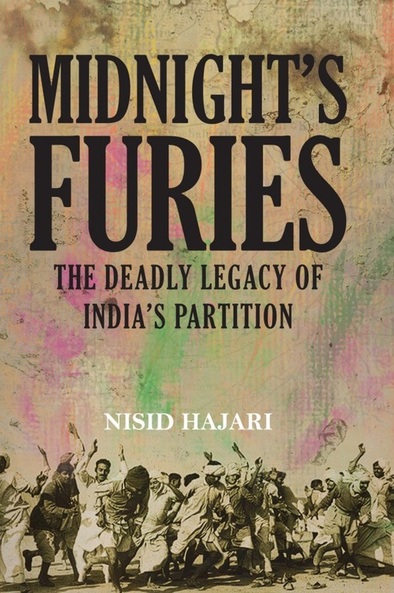
When so many histories of Partition sidestep Kashmir altogether, it's refreshing that Nisid Hajari's lively and well-written book pays proper attention to events in the Valley - and not simply the tussle over accession but also the impact of the lashkar's invasion and the human consequences of those early stages in the conflict. His book folds in the high politics of independence and Partition with the lived experience of that calamity. It starts rather uncertainly, but gathers paces and authority as the author - a journalist - relaxes into his narrative.
The most arresting aspect of Hajari's account is the manner in which he seeks to debunk the notion that Partition violence was spontaneous and haphazard, the consequence of inflamed passions rather than planning and political motive. This is not a partisan account, but Hajari suggests that the Sikh Akalis led by Tara Singh, the community which arguably was most gravely disadvantaged by the drawing of the Radcliffe line, were the most determined and ruthless in pursuit of communal violence.
Hajari has done his research well - trawling through archives in the UK and the US as well as India, and with admirable mastery of the secondary sources. He had not pursued oral history or conducted his own interviews with the dwindling number who lived through Partition, but makes good use of the personal stories which are already part of the historical record.
His chapters on Kashmir are well informed and clearly expressed. He accepts what is slowly becoming the conventional wisdom among historians, that Hari Singh signed the accession document to India not on 26th October 1947, as the official record states, but on the following day. In other words, he didn't formally sign up to India until some hours after the military airlift from Delhi to Srinagar was underway. The only slight blemish is Hajari's use of an American journalist's account of events in Baramulla to suggest that only a thousand of the town's 14,000 residents survived the fighting in late October and early November 1947. In fact, the figure reflects simply that almost all the townspeople had fled not that they had perished. (AW)
The most arresting aspect of Hajari's account is the manner in which he seeks to debunk the notion that Partition violence was spontaneous and haphazard, the consequence of inflamed passions rather than planning and political motive. This is not a partisan account, but Hajari suggests that the Sikh Akalis led by Tara Singh, the community which arguably was most gravely disadvantaged by the drawing of the Radcliffe line, were the most determined and ruthless in pursuit of communal violence.
Hajari has done his research well - trawling through archives in the UK and the US as well as India, and with admirable mastery of the secondary sources. He had not pursued oral history or conducted his own interviews with the dwindling number who lived through Partition, but makes good use of the personal stories which are already part of the historical record.
His chapters on Kashmir are well informed and clearly expressed. He accepts what is slowly becoming the conventional wisdom among historians, that Hari Singh signed the accession document to India not on 26th October 1947, as the official record states, but on the following day. In other words, he didn't formally sign up to India until some hours after the military airlift from Delhi to Srinagar was underway. The only slight blemish is Hajari's use of an American journalist's account of events in Baramulla to suggest that only a thousand of the town's 14,000 residents survived the fighting in late October and early November 1947. In fact, the figure reflects simply that almost all the townspeople had fled not that they had perished. (AW)
Nisid Hajari, Midnight's Furies: the deadly legacy of India's Partition, Amberley, 2015, ISBN: 978-1-4456-4793-7
Gulzar Mufti - 'Kashmir in Sickness and in Health' - short notice
|
Gulzar Mufti is a doctor - Srinagar-born and raised and now working as a consultant urologist in England - who has written a lively account of the development of health provision in his home city and across the Valley. He discusses traditional forms of medicine, the hakims and midwives, as well as the considerable role of Christian missionaries in introducing allopathic medicine, and the building of the dispensaries and hospitals which serve the people of Kashmir.
This book, however, roams much wider - looking at the introduction of schools, both Church and Islamic; the struggle for decent sanitation and public health in Srinagar; and a largely personal account of growing up in the city, the politics of the Valley, and its descent into agony from 1989. The book is well informed and written and displays great compassion and concern for the welfare of the people of Kashmir. The author offers some judgements which are worth reflecting on - whatever the many failings of the Dogra maharajahas, he suggests, they funded important initiatives towards better public health. And on the political front, while Mufti is keenly aware of the shortcomings of Kashmir's modern rulers, he also offers the opinion that Sheikh Abdullah was 'probably the only leader that Kashmir has produced'. (AW) |
Gulzar Mufti, Kashmir in Sickness and in Health, Partridge India, 2013, ISBN:978-1-4828-0999-2
Nyla Ali Khan - 'The Life of a Kashmiri Woman' - short notice
|
Nyla Ali Khan, an academic based in the US, has written an account of her maternal grandmother, the formidable Akbar Jehan, born into the Nedou family and the wife and comrade of Sheikh Abdullah. She is one of the most interesting and influential women in Kashmir's modern history and it is good to have a book devoted to her life and influence. Unsurprisingly, the emphasis here is on the personal - and there's a great deal of fascinating information about, and wonderful photographs of, the Nedou family, whose roots lie in the Austro-Hungarian empire and came to be Kashmir's leading hoteliers.
The author at times digresses into personal reflection, and there are many questions which remain only partly addressed: why did the Nedou family convert to Islam? how did Akbar Jehan and Sheikh Abdullah, in some ways from different worlds, meet and find concord? did Akbar Jehan, an important political figure in her own right, stand by her husband out of personal loyalty or political conviction or both? So there's quite a lot still to explore, but a big gap in Kashmir's historiography is starting to be filled. (AW) |
Nyla Ali Khan, The Life of a Kashmiri Woman: dialectic of resistance and accommodation, Palgrave Macmillan, 2014, ISBN: 978-1-137-46563-4
Chitralekha Zutshi - 'Kashmir's Contested Pasts'
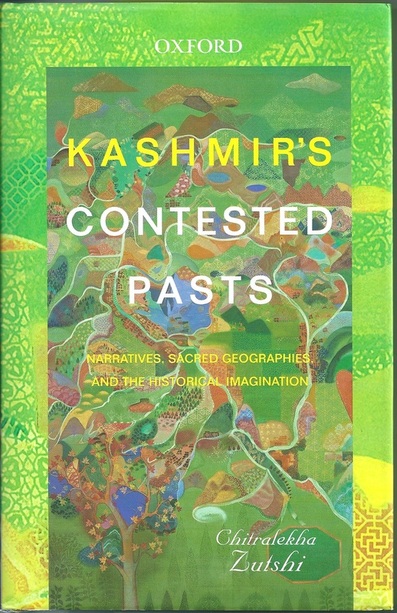
'I hope that this book contributes to an understanding of the sheer diversity of voices that have shaped Kashmir's past, and indeed the very idea of Kashmir itself,' says Chitralekha Zutshi at the close of this impressively researched and argued book, 'thus helping us to imagine a more inclusive future for the region and its people.'
Chitralekha Zutshi has immersed herself in accounts of Kashmir's past from the twelfth-century Sanskrit Rajatarangini, through later chronicles, hagiographies and histories in Sanskrit, Persian and Urdu, to near contemporary folk theatre and story telling in Kashmiri, to explore the development of a concept of Kashmir - geographical, religious and national - and how historiography has both informed and become ensnared by increasingly polarised political debate. This is her second book - Languages of Belonging: Islam, regional identity and the making of Kashmir was published in 2003 - and is again an expression of a keen commitment both to scholarship and to Kashmir.
She insists that the people of Kashmir were not merely passive victims in a series of Imperial conquests, and seeks to redefine Kashmir's historical tradition by examining sometimes neglected forms of recording the past, from Persian tarikhs to Kashmiri oral traditions. The Persian writings, sometimes regarded (wrongly in Zutshi's view) as derivative and unrewarding, sought to present Kashmir as a sacred space, an Islamic space, while at times advancing the interests of particular Sufi orders. After the Mughal conquest, historiography increasingly placed emphasis on Kashmir as a political unit, a territory and a people, within a larger Islamic space. In the nineteenth century, as Persian declined and Urdu started to take its place, histories were increasingly informed by a sentiment that Kashmir and its people had been unwillingly drawn into larger Imperial entities. As ever, the way in which the past was perceived and recorded was shaped by current political concerns and motives.
Zutshi examines the remarkable Rajatarangini principally through its colonial - that is, orientalist - and then Indian nationalist rediscovery. The simple fact that the only substantial Sanskrit work which can be regarded as a history was produced in Kashmir has been taken as an indication of the deep historic links between Kashmir and India. And its composition prior to Kashmir's conversion to Islam has been seen as indicating Kashmir's place in an underlying Hindu culture and history. On the other hand, a Kashmiri nationalist tradition - expressed in historical writing, Kashmiri poetry and orally - has put forward a very different account of 'downtrodden Kashmiris'. There have, Zutshi asserts, been multiple attempts to annex Kashmir's past, usually 'casting the present conflict in Kashmir in terms of an inevitable struggle between Hindus and Muslims'.
The most engrossing part of Chitralekha Zutshi's research is her account of the emergence of what she calls a 'Kashmiri narrative public', an informed Kashmiri audience for historical narrative, whether in print or as part of on oral or performance tradition. She looks at the development of Kashmiri publishing (initially largely in Lucknow and Lahore) and bookselling, and at the endurance and adaptation of folk traditions - including by the progressive movement which shone brightly, if briefly, in the Kashmir valley. She argues that while the Kashmiri language lacked state patronage, and was not a crucible of political debate, it remained vibrant because of the endurance of storytelling, theatre and recitation - and this in turn reinforced Kashmiris' sense of individuality and historical identity.
Her concluding chapter is entitled 'The Divided Public' and concerns the manner in which different political traditions have sough to co-opt and distort historical narratives - 'ideology masquerading as history', she complains. At the heart of this contestation, she says, is the debate about the idea of Kashmiriyat, the concept of a syncretic culture which she argues was promulgated after 1947 by the Kashmiri political establishment for a political purpose. 'Kashmiriyat is a bankrupt academic concept,' she asserts, 'but one cannot use its rejection as a means to erase centuries of inter-religious, inter-regional, and multi-linguistic interactions that have shaped Kashmir in the past and continue to shape it in the present.'
Zutshi is likely to delve still more deeply into this disputed area with her next project - she recently told the Kashmir Times that she's starting work on a biography of Sheikh Abdullah. That's an exciting prospect. (AW)
The most engrossing part of Chitralekha Zutshi's research is her account of the emergence of what she calls a 'Kashmiri narrative public', an informed Kashmiri audience for historical narrative, whether in print or as part of on oral or performance tradition. She looks at the development of Kashmiri publishing (initially largely in Lucknow and Lahore) and bookselling, and at the endurance and adaptation of folk traditions - including by the progressive movement which shone brightly, if briefly, in the Kashmir valley. She argues that while the Kashmiri language lacked state patronage, and was not a crucible of political debate, it remained vibrant because of the endurance of storytelling, theatre and recitation - and this in turn reinforced Kashmiris' sense of individuality and historical identity.
Her concluding chapter is entitled 'The Divided Public' and concerns the manner in which different political traditions have sough to co-opt and distort historical narratives - 'ideology masquerading as history', she complains. At the heart of this contestation, she says, is the debate about the idea of Kashmiriyat, the concept of a syncretic culture which she argues was promulgated after 1947 by the Kashmiri political establishment for a political purpose. 'Kashmiriyat is a bankrupt academic concept,' she asserts, 'but one cannot use its rejection as a means to erase centuries of inter-religious, inter-regional, and multi-linguistic interactions that have shaped Kashmir in the past and continue to shape it in the present.'
Zutshi is likely to delve still more deeply into this disputed area with her next project - she recently told the Kashmir Times that she's starting work on a biography of Sheikh Abdullah. That's an exciting prospect. (AW)
Chitralekha Zutshi, Kashmir's Contested Pasts: narratives, sacred geographies, and the historical imagination, Oxford University Press, 2014, ISBN-13: 978-0-19-945067-1, ISBN-10: 0-19-945067-6
Manisha Sobhrajani, 'The Land I Dream Of' - short notice
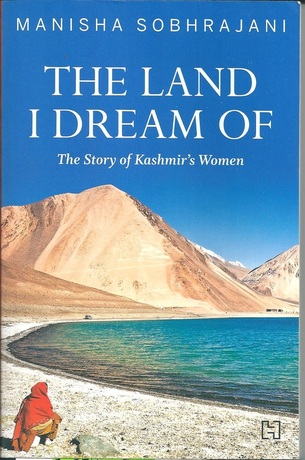
At the heart of Manisha Sobhrajani's book are accounts of the lives of individual women from across Jammu & Kashmir - a Pandit woman, a 'half-widow', a woman from Kunan Poshpora where Indian security forces allegedly conducted a mass rape, a Ladakhi woman and a woman associated with the separatist militancy.
'Kashmiri women - mothers, wives, sister and daughters -' Sobhrajani asserts, 'have spent the better part of their lives negotiating space for their menfolk and living through the conflict in their own ways. For Kashmiri women, it has become a way of life to take up the issue of missing sons and husbands; some of them have fought in the conflict, participated in it wilfully or hid militants at their homes. Yet, it is women whose viewpoint has been sidelined, ignored, even suppressed.'
For historians the most compelling section is the brief account of meetings with a Hindu woman, Sukanya Parashar, a veteran of the National Conference's Women's Self Defence Corps in 1947-48 - 'a defining moment in the history of Kashmir, and definitely a defining moment in the lives of the women who were a part of it.' The book details the extent to which veterans of this militia went on to become pioneers in women's education in the Kashmir valley. (AW)
Manisha Sobhrajani, The Land I Dream Of: the story of Kashmir's women, Hachette India, 2014, ISBN: 978-93-5009-222-4
'Kashmiri women - mothers, wives, sister and daughters -' Sobhrajani asserts, 'have spent the better part of their lives negotiating space for their menfolk and living through the conflict in their own ways. For Kashmiri women, it has become a way of life to take up the issue of missing sons and husbands; some of them have fought in the conflict, participated in it wilfully or hid militants at their homes. Yet, it is women whose viewpoint has been sidelined, ignored, even suppressed.'
For historians the most compelling section is the brief account of meetings with a Hindu woman, Sukanya Parashar, a veteran of the National Conference's Women's Self Defence Corps in 1947-48 - 'a defining moment in the history of Kashmir, and definitely a defining moment in the lives of the women who were a part of it.' The book details the extent to which veterans of this militia went on to become pioneers in women's education in the Kashmir valley. (AW)
Manisha Sobhrajani, The Land I Dream Of: the story of Kashmir's women, Hachette India, 2014, ISBN: 978-93-5009-222-4
John Keay, 'Midnight's Descendants' - short notice
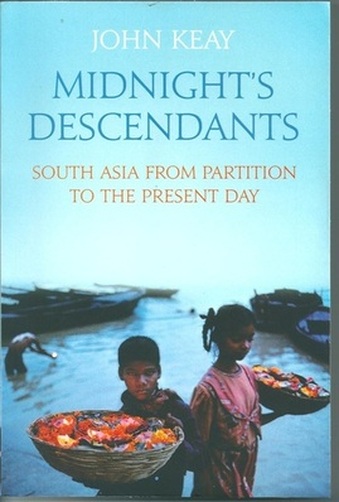
John Keay's lively and wide-ranging popular history of modern south Asia has much to say about Kashmir, including a chapter devoted to the early stages of the Kashmir conflict.
The chapter title - 'Who has not heard of the Vale of Cashmere?' - points to the book's slightly old-fashioned approach and style (it's 'the Punjab' for instance) and its tilt towards a western readership.
As if to underline both these points, the chapter is punctuated by the pithy observations of Ghulam Mohamed, a houseboat proprietor who Keay met in Kashmir in 1967. Ghulam Mohamed, indeed, provides the chapter's opening words:
''But Sahib, we are Kashmiris, see. We are not Indians."
The book's focus is political rather than social or economic history, and while eminently readable it is best described as informed rather than authoritative. It doesn't say much that is new but is sure-footed in its approach, as you would expect of an author who has written so extensively about south Asia. And this is a rare account of the region's history which gives proper attention to Kashmir. (AW)
John Keay, Midnight's Descendants: South Asia from Partition to the present day, William Collins, 2014, ISBN: 978-0-00-756511-5
The chapter title - 'Who has not heard of the Vale of Cashmere?' - points to the book's slightly old-fashioned approach and style (it's 'the Punjab' for instance) and its tilt towards a western readership.
As if to underline both these points, the chapter is punctuated by the pithy observations of Ghulam Mohamed, a houseboat proprietor who Keay met in Kashmir in 1967. Ghulam Mohamed, indeed, provides the chapter's opening words:
''But Sahib, we are Kashmiris, see. We are not Indians."
The book's focus is political rather than social or economic history, and while eminently readable it is best described as informed rather than authoritative. It doesn't say much that is new but is sure-footed in its approach, as you would expect of an author who has written so extensively about south Asia. And this is a rare account of the region's history which gives proper attention to Kashmir. (AW)
John Keay, Midnight's Descendants: South Asia from Partition to the present day, William Collins, 2014, ISBN: 978-0-00-756511-5
